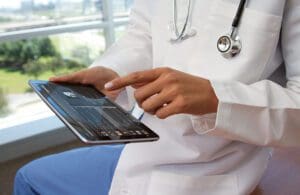
[Image courtesy of NEC Corp. of America via Flickr]
While numerous types of technology have a rightful place in life sciences to cut down on errors, decrease costs and boost efficiency, the adverse event intake and collection process remains primarily manual. It’s common for organizations to use software to support adverse event intake, but end-user intervention is often necessary to collect, input and share data.
This practice poses a problem because pharmacovigilance is a team sport. Patients, patient support programs, local representatives of a life science organization, healthcare providers and pharmacovigilance physicians are all needed to contribute to and review an adverse event report before it gets sent to a government regulatory agency. It is critical to gather and understand these insights before reporting is underway.
Beyond this workflow challenge, organizations often face a problem of scalability. The number of adverse events reported annually is only increasing, and adverse event reporting requirements are only getting more complex, especially as regulations and guidance changes. For modern, multinational life science organizations — as well as startups and mid-market size firms — existing methods of collecting cases are increasingly insufficient to meet the needs.
That’s where case collection systems enter the picture. Such a system can accept adverse events reports from multiple stakeholders in multiple locations and languages. In addition, case collection systems can automate risk management, which streamlines the review of medical correspondence. When used upstream of the adverse event intake process, case collection systems help organizations keep pace with increased report volume without making significant changes to existing workflows or staffing levels.
Explaining the difference between intake and case collection systems
It’s helpful to understand what adverse intake reporting systems and case collections can do on their own before discussing the benefits of their combined solution.
Beginning with the intake system, this solution is used to directly support the Safety System used for reporting suspected adverse events to government agencies from the market authorization holder (MAH). Additionally, it will process and transfer cases into the correct format for the global safety system. However, the drawback of this system is that they are meant to be used by the MAH only; it relies on limited single data entry forms.
Meanwhile, a collection system allows a greater and more diverse population to report adverse events. Whether it be a physician, advocacy group or patient, these systems are designed to be more user-friendly with web- and mobile-based platforms in multiple languages. Collection systems also support custom user interfaces so that the UI for physicians isn’t the same as the UI for consumers. The key difference to note is that collection systems integrate with intake systems to share information directly, negating the need for manual data entry and eliminating potential data entry errors.
Proposing a new approach to case collection
The complexity involved in the local processing of adverse events highlights the value proposition of the case collection system. When an event is reported, it is sent up from the individual – many times the patient or physician – to the local affiliate and then on to medical specialist who reviews it for accuracy. Yet, if the medical specialist has a question or requires more information, the process must be done in reverse. It is highly unsuccessful and laborious to complete.
We have seen a growing awareness of pharmacovigilance process due to the recent pandemic. It results in a steady increase in the number of adverse events shared by all parties — at approximately 15% yearly. This volume cannot be successfully handled manually by current medical specialist teams – especially if translation of the data into English is required. Thus, automation of case collection systems is critical for life science companies to leverage in the coming years.
Offering better safety through data collection
The correct reporting and analysis of adverse event reports are essential for supporting and complying with local regulations and guidance. With automation services, an organization can eliminate the need for translation and offshore processing, such as the manual redaction of personal information, which saves time, cuts costs and reduces concerns about information getting lost in translation.
By integrating directly with safety systems, case collection systems remove the need to enter case information manually. If an organization is entering and reviewing hundreds of thousands of reports, reducing this manual task allows staff to focus their time and efforts on high-quality projects. Integration also allows for data consistency among the intake system, case collection system, and safety system. Along with ensuring accuracy, this streamlines the timely but important data reconciliation process.
Finally, case collection systems take the extra step to address risk management. Using AI, systems can flag serious adverse events and provide alerts for immediate identification and follow-up correspondence with whoever reported the event. This leads to higher response rates than written letters, which often arrive at physicians’ offices weeks after an event was first reported.
Product safety is the ultimate goal of pharmacovigilance. With a case collection system in place, life science organizations are positioned to process more adverse event reports from more sources in less time and share this information with safety systems without any manual data entry. Through these automated workflows, organizations identify adverse events sooner. This results in better compliance with a wide range of global adverse event regulations and faster correspondence with the physicians reporting adverse and, ultimately, better outcomes for the patients using a given therapy.

Andrew Donaldson
Andrew Donaldson is the head of pharmacovigilance and regulatory technology at IQVIA. Andrew has been working in the Pharmacovigilance sphere for 18 years as a Business Consultant and Program Manager. Andrew has an MBA from Henley Business School, Oxford, England.